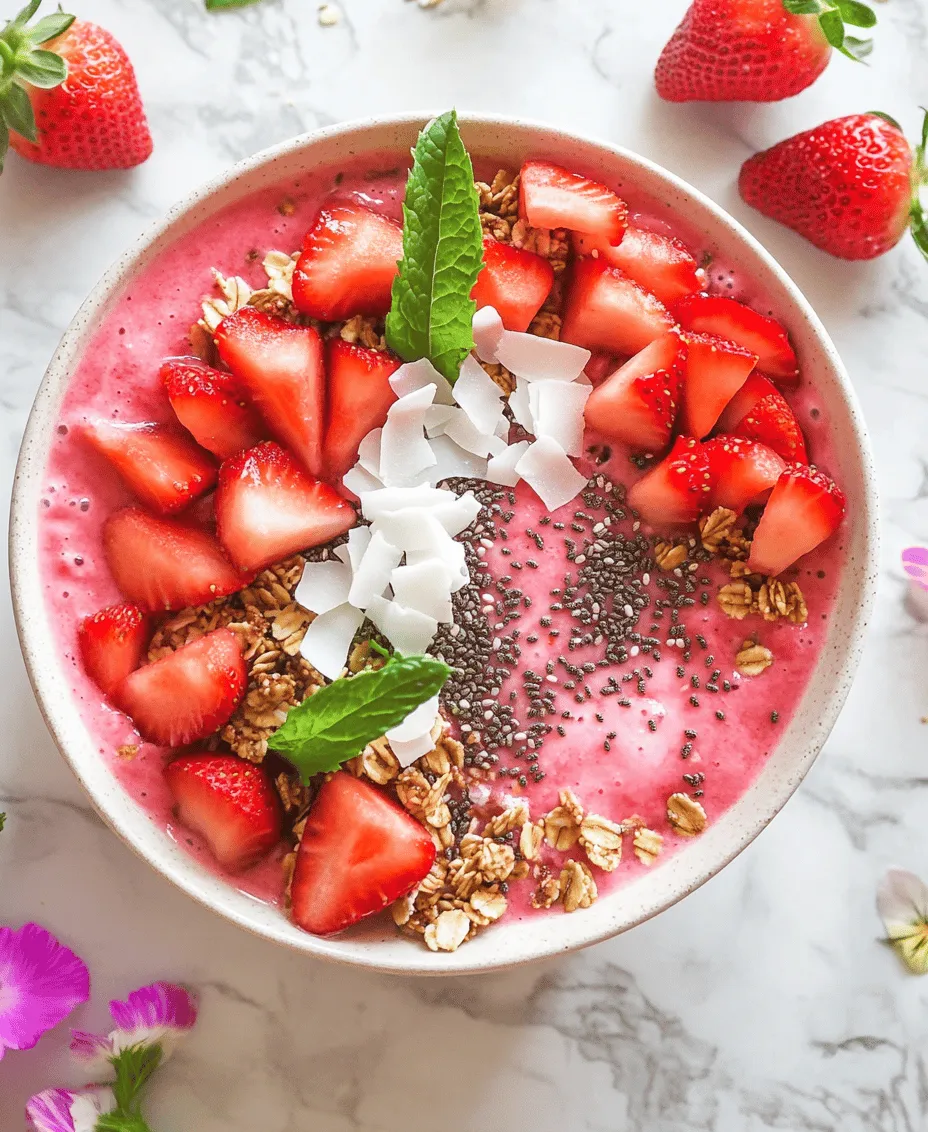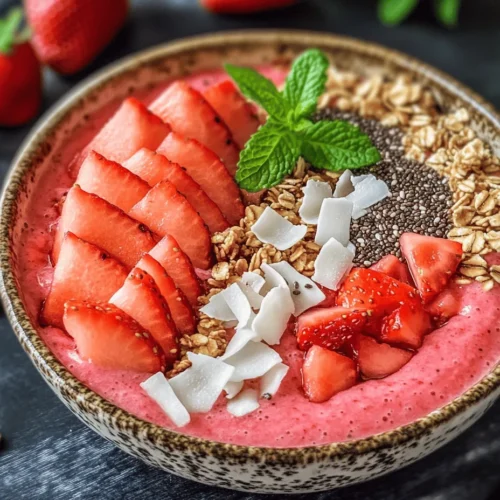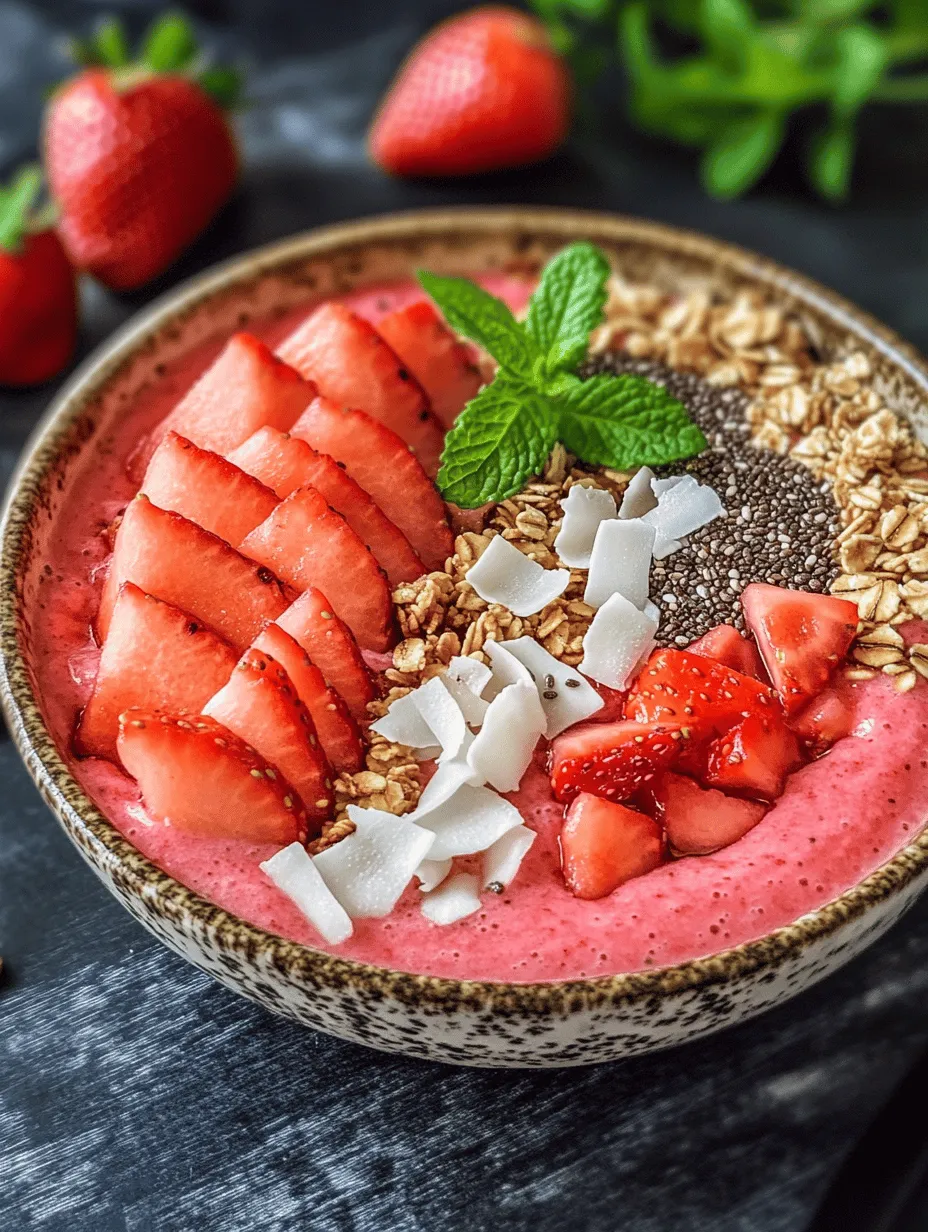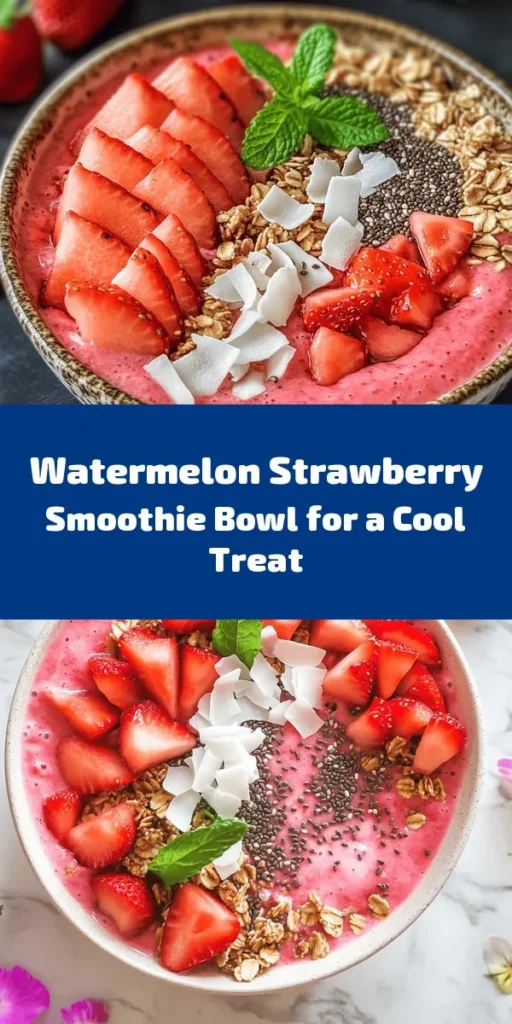In the world of nutritious breakfasts and snacks, smoothie bowls have emerged as a trendy and appealing option that blends health with aesthetics. These vibrant bowls are not only visually stunning, but they also offer a refreshing burst of flavors that can invigorate your mornings or serve as a delightful afternoon treat. Among the myriad of smoothie bowl combinations, the watermelon and strawberry smoothie bowl stands out with its juicy sweetness and rejuvenating properties.
Watermelon and strawberries are not only delicious but also packed with numerous health benefits. The hydrating properties of watermelon combined with the antioxidant-rich profile of strawberries create a harmonious blend that nourishes the body and delights the taste buds. This recipe is simple, quick to prepare, and can easily be tailored to suit your preferences, making it a perfect choice for those who prioritize health without compromising on flavor.
Exploring the Ingredients
To achieve the best flavor and nutritional profile in your watermelon and strawberry smoothie bowl, it’s essential to understand the ingredients that make this dish so special. Let’s delve into each component and explore their health benefits and taste characteristics.
Watermelon: Hydration and Vitamins
Watermelon is the star of this smoothie bowl, providing a hydrating base that is ideal for warm days. Composed of about 92% water, this fruit is perfect for keeping you hydrated. It is also rich in vitamins A and C, both of which are crucial for maintaining healthy skin and immune function. Additionally, watermelon contains lycopene, an antioxidant that has been linked to numerous health benefits, including reduced risk of heart disease and cancer. The subtle sweetness of watermelon adds a refreshing touch to the smoothie bowl, making it an ideal component for this recipe.
Strawberries: Antioxidants and Fiber
Strawberries, with their vibrant red hue, add not only flavor but also a wealth of nutritional benefits. These berries are packed with antioxidants, particularly vitamin C and manganese, which help combat oxidative stress and inflammation in the body. They are also a good source of dietary fiber, which aids in digestion and promotes a feeling of fullness. The natural sweetness of strawberries complements the mild taste of watermelon, creating a balanced flavor profile that is both sweet and refreshing.
Banana: Natural Sweetness and Potassium
Bananas are another essential ingredient in this smoothie bowl. They provide natural sweetness and a creamy texture, making them an excellent addition. Rich in potassium, bananas help maintain healthy blood pressure levels and are a great source of energy. Their smooth consistency helps bind the ingredients together, ensuring a creamy and satisfying bowl. When combined with watermelon and strawberries, bananas enhance the overall flavor and nutritional value of the smoothie.
Coconut Water: Hydration and Electrolytes
Coconut water serves as the perfect liquid base for your smoothie bowl. Known for its hydrating properties, coconut water is packed with electrolytes, making it an excellent choice after workouts or on hot days. Its natural sweetness complements the fruits without overpowering them, allowing the flavors of the watermelon and strawberries to shine through. Additionally, coconut water is low in calories and rich in potassium, making it a healthy alternative to juice or sugary beverages.
Honey or Maple Syrup: Natural Sweeteners and Their Health Benefits
While the fruits provide natural sweetness, you may choose to enhance the flavor further with a drizzle of honey or maple syrup. Both options are natural sweeteners that can boost the overall taste of your smoothie bowl. Honey has antimicrobial properties and can aid in digestion, while maple syrup offers a unique flavor and is rich in antioxidants and minerals. When using sweeteners, it’s essential to find a balance that enhances the dish without making it overly sweet.
Greek Yogurt: Protein and Creaminess (Optional)
For those looking to add a touch of creaminess and a protein boost, Greek yogurt is an excellent option. This ingredient not only enhances the texture of the smoothie bowl but also increases its nutritional value by providing probiotics and calcium. Greek yogurt can be particularly beneficial for those who are active and need a protein-rich breakfast or snack. If you’re looking for a dairy-free alternative, consider using a plant-based yogurt to maintain the creamy consistency.
Toppings: Nutritional Value and Visual Appeal
The beauty of a smoothie bowl lies not only in its base but also in its toppings. From granola and seeds to fresh fruit and nuts, the options are endless and can significantly enhance the nutritional profile of your bowl. Toppings such as chia seeds, which are rich in omega-3 fatty acids and fiber, or sliced almonds for added crunch and healthy fats, can elevate your smoothie bowl both in taste and appearance. Fresh berries, shredded coconut, or a sprinkle of hemp seeds can provide additional color and texture, making your smoothie bowl an Instagram-worthy dish.
The Art of Blending
Achieving the perfect texture is crucial when creating a smoothie bowl. The goal is to attain a thick, creamy consistency that holds up under the weight of your toppings. Here are some tips to ensure you get that ideal texture:
Importance of Using Frozen Fruits for a Thick Consistency
Using frozen fruits is essential for creating a thick and creamy smoothie bowl. When blended, frozen fruits yield a dense texture that can withstand the addition of toppings without becoming too soupy. For this recipe, consider freezing your watermelon, strawberries, and banana beforehand. If you don’t have frozen fruit on hand, you can quickly freeze fresh fruit by cutting it into chunks and placing it in the freezer for a couple of hours.
How to Adjust Texture with Liquid or Additional Frozen Fruit
If your smoothie bowl ends up being too thick, you can adjust the texture by adding a splash of coconut water or another liquid of your choice. Conversely, if your blend is too thin, incorporate more frozen fruit until you achieve the desired consistency. A well-balanced smoothie bowl should be thick enough to hold its shape but smooth enough to be easily spoonable.
Tips for Layering Flavors While Blending
When blending your ingredients, consider layering flavors for an added depth of taste. Start with the liquid base, followed by the softer fruits like bananas, and then add the watermelon and strawberries. This layering technique ensures that the blades of your blender can effectively process the ingredients, resulting in a smoother consistency. Blend the mixture until it reaches a creamy texture, stopping occasionally to scrape down the sides of the blender to ensure even blending.
Step-by-Step Instructions
Creating a watermelon and strawberry smoothie bowl is a straightforward process that can be broken down into a few simple steps. Follow these instructions to ensure a successful and enjoyable experience in the kitchen.
Preparing the Ingredients: Freezing Fruits and Measuring
1. Select Your Fruits: Choose ripe watermelon, strawberries, and bananas. For the best flavor, opt for fruits that are in season.
2. Cut and Freeze: Slice the watermelon and bananas into manageable chunks, and place them in the freezer for at least two hours. For strawberries, you can remove the stems and freeze them whole or sliced, depending on your preference.
3. Measure Your Ingredients: While the fruits are freezing, gather the other ingredients. You’ll need coconut water, honey or maple syrup, and Greek yogurt if desired. Measure out the amounts according to the recipe, ensuring you have everything ready for blending.
Blending Process: Techniques for Smooth Consistency
1. Start with the Liquid: Pour the coconut water into your blender first. This liquid base helps the blending process and prevents the blades from getting stuck.
2. Add the Soft Ingredients: Next, add in the Greek yogurt (if using) and the banana. Blend these together until smooth.
3. Incorporate the Frozen Fruits: Finally, add the frozen watermelon and strawberries. Blend on high until you achieve a thick, creamy consistency. Stop to scrape down the sides as needed to ensure all ingredients are well combined.
4. Adjust Consistency: If the mixture is too thick, add a little more coconut water; if it’s too thin, add more frozen fruit and blend again until smooth.
Through these steps, you’ll create a delicious and refreshing watermelon and strawberry smoothie bowl that not only delights the palate but also nourishes the body. The vibrant colors and enticing aromas will make this dish an inviting addition to your breakfast or snack repertoire. Enjoy the process of blending and layering flavors, and get ready to indulge in a bowl of pure goodness.

Adjusting Sweetness: How to Taste and Modify the Blend
Achieving the perfect balance of sweetness in your Watermelon and Strawberry Smoothie Bowl is crucial to making it not only delicious but also refreshing. When blending your ingredients, it’s essential to taste the mixture before serving. The natural sweetness of watermelon and strawberries can vary, so you might find that you want to adjust the sweetness level to suit your preference.
Start by blending the watermelon and strawberries until smooth, then take a small spoonful to taste. If the blend isn’t sweet enough for your liking, consider adding a natural sweetener like honey, agave syrup, or maple syrup. Begin with a small amount, about one teaspoon, and blend again. Taste it once more, and repeat the process if necessary. Remember, it’s easier to add sweetness than to take it away, so go gradually!
Adding Greek Yogurt: Tips for Incorporating Without Losing Texture
Greek yogurt is not only a great source of protein, but it also adds creaminess to your smoothie bowl. To incorporate Greek yogurt without compromising the texture, it’s best to add it in stages. After blending your fruits, scoop out half of the mixture into a bowl. Then, add a generous dollop of Greek yogurt (about ¼ to ½ cup) to the remaining mixture in your blender and pulse gently until just combined. This method ensures that your smoothie remains thick and creamy while preserving its frothy texture.
If you prefer a lighter consistency, consider using lighter yogurt options or even a plant-based yogurt for a dairy-free variant. Blend it in softly, so you maintain the airy quality that makes smoothie bowls so enjoyable. This technique allows you to enjoy the health benefits of yogurt while keeping the integrity of your smoothie bowl intact.
Pouring and Serving: Achieving the Perfect Presentation
Presentation plays a significant role in the enjoyment of your smoothie bowl. To achieve a visually appealing pour, use a ladle or large spoon. Start by tilting your bowl slightly and pouring the smoothie mix in a circular motion. This technique helps to create a lovely, even layer across the bottom of the bowl.
Once poured, the next step is to enhance visual appeal. Smooth the top with the back of a spoon for a polished finish. You might also consider creating a slight mound in the center for an inviting look.
Creative Presentation Ideas
Making your smoothie bowl visually appealing can enhance the overall experience of enjoying it. Here are some creative presentation ideas to elevate your smoothie bowl:
1. Arranging Toppings: The way you arrange your toppings can significantly increase the visual aesthetics of your smoothie bowl. Instead of simply scattering toppings, try creating patterns or sections. For example, line up slices of fresh strawberries, blueberries, and banana in rows or create a spiral effect with nuts and seeds.
2. Unique Topping Combinations: Experiment with various toppings to add texture and flavor depth. Here are a few unique combinations to consider:
– Nuts and Seeds: Almonds, walnuts, chia seeds, or hemp seeds can provide a delightful crunch.
– Dried Fruits: Consider adding dried coconut flakes, goji berries, or cranberries for a sweet chewiness.
– Granola: A sprinkle of homemade or store-bought granola can add both texture and a delicious nutty flavor.
3. Color Theory: Utilizing the colors of your ingredients can enhance the appeal of your smoothie bowl. Brightly colored fruits like kiwi, mango, or pomegranate can contrast beautifully against the pastel pink of your watermelon and strawberry base. This not only makes your bowl more visually inviting but also indicates a variety of nutrients.
Health Benefits of Smoothie Bowls
Smoothie bowls are not only delicious but also packed with health benefits, making them a fantastic addition to your diet. Here’s a closer look at some of the nutritional advantages of the key ingredients in your Watermelon and Strawberry Smoothie Bowl:
1. Nutritional Advantages of Key Ingredients:
– Watermelon: Rich in vitamins A and C, watermelon is hydrating and low in calories, making it an excellent choice for refreshing snacks.
– Strawberries: They are a great source of antioxidants, particularly vitamin C and manganese, and are known for their anti-inflammatory properties.
– Greek Yogurt: Packed with protein and probiotics, Greek yogurt supports digestive health and enhances muscle recovery.
2. Benefits of Consuming Fruits and Yogurt Regularly: Incorporating fruits into your diet can improve immune function and promote healthy skin. Yogurt contributes to gut health and can even aid in weight management by keeping you feeling full longer due to its protein content.
3. Discussing Portion Control and Mindful Eating: Smoothie bowls encourage mindful eating by presenting a colorful, enticing dish that invites you to savor every bite. By controlling the portion size of your toppings and the smoothie base, you can indulge without overdoing it. This method promotes healthy eating habits and allows you to enjoy a variety of flavors and textures.
Variations and Customizations
One of the best aspects of smoothie bowls is their versatility. Here are some ideas for how you can modify the Watermelon and Strawberry Smoothie Bowl recipe to fit your preferences or dietary needs:
1. Alternative Fruit Combinations: Feel free to experiment with seasonal fruits. You can substitute or add fruits such as blueberries, peaches, or kiwi to create a unique flavor profile. Each fruit brings its own health benefits and flavor nuances.
2. Different Liquid Bases: Instead of using plain water or fruit juice, consider plant-based milks like almond, coconut, or oat milk to enhance the creaminess of your smoothie. Coconut water can also add a refreshing twist while hydrating.
3. Vegan Alternatives: For a vegan-friendly version, swap Greek yogurt for a dairy-free yogurt alternative made from coconut, almond, or soy. You can also use agave syrup or stevia as sweeteners instead of honey for those following a plant-based diet.
Conclusion
The Watermelon and Strawberry Smoothie Bowl is not just a treat for the taste buds; it’s a visual delight that offers a wealth of health benefits. Its refreshing flavor and vibrant colors make it an ideal choice for breakfast, a snack, or even dessert. The ease of preparation allows anyone to whip up this nutritious bowl in no time, while its versatility invites creativity in the kitchen.
By exploring various toppings, alternative ingredients, and presentation styles, you can tailor this recipe to suit your taste and dietary preferences. Embrace the joy of smoothie bowls and let your creativity flow as you experiment with flavors and aesthetics. Whether enjoyed on a hot summer day or as a nutritious start to your morning, this smoothie bowl is sure to become a favorite in your household.



